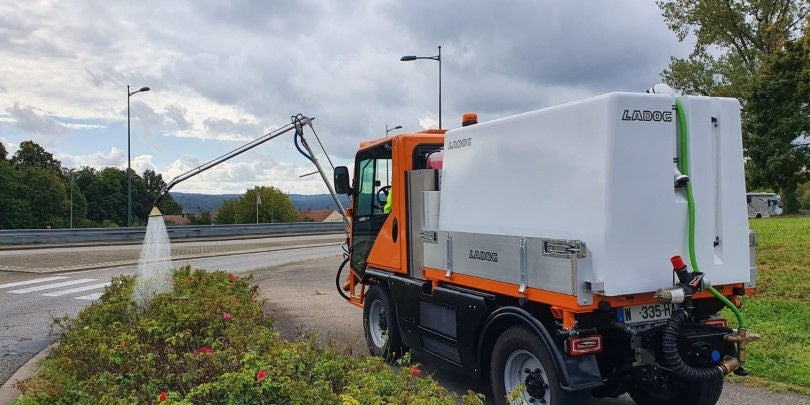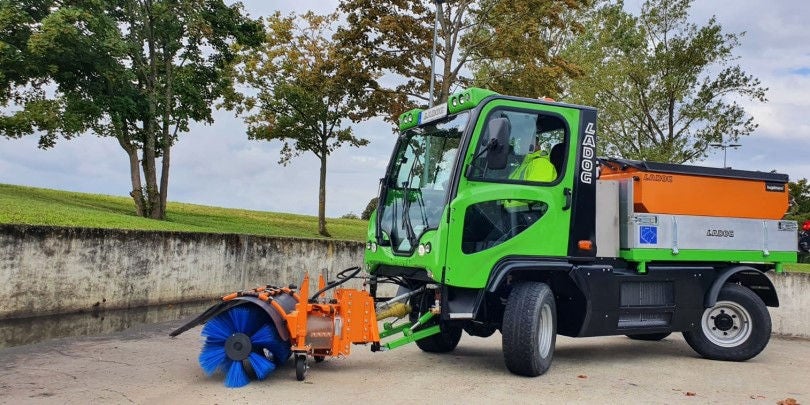LADOG and Webasto get
electric mobility moving

Whether street cleaning, winter road clearance or maintaining public green spaces – some municipal tasks are best handled by specially designed narrow track and compact vehicles. Family-owned company LADOG from Zell am Harmersbach has made an international name for itself as a manufacturer. A typical feature of LADOG vehicles is that they can, as multi-purpose vehicles, be converted from summer to winter mode and are deployable for a wide range of tasks. This distinguishes the company’s models from those of other manufacturers who, for example, may solely build sweepers. The next step for LADOG is to electrify the vehicles in its current portfolio. To kick off this project with two vehicles initially, the Black Forest-based company is relying on battery solutions from Webasto.
Sustainable concepts for commercial vehicles in public services
“Electromobility simply embodies the spirit of the times,” explains Björn Guggenbühler, Managing Director of LADOG Fahrzeugbau und Vertriebs GmbH. “The German Federal Climate Protection Act stipulates that greenhouse gas emissions from the transport sector must decrease by 48 percent by 2030 compared to 2019 levels. In order to achieve this ambitious objective, local authorities are also called upon to act.” The German Federal Ministry of Digital Affairs and Transport is therefore supporting numerous purchases of electrified vehicles through to 2025 as part of the “Electromobility Funding Guideline”. This will accelerate the switch to alternative drive systems by companies and municipalities alike. Electric mobility is therefore already a key issue facing municipalities for many reasons – and will take on even greater significance in future. However, it is also especially interesting that the vehicles’ field of application is ideally suited to battery-electric drive concepts. The strength offered by full electrification, compared to diesel vehicles with hydrostatic transmission, is the high level of efficiency achieved, which reaches almost 90 percent. When the machine is working at a standstill, only the attachments run – not a diesel engine that powers the auxiliary drives. The vehicles can also return to the depot for drivers’ breaks, where they can be rapidly charged. “Battery capacity is normally sufficient for a day’s work, but on the odd occasion when it runs low, the break can be used for recharging,” continues Guggenbühler. “As a company with roots in traditional trades, we tackled the conversion and brought in external support where necessary.”
Buyers of these vehicles are primarily municipalities and service companies, many of which work for cities and municipalities. During the electrification of its vehicles, LADOG paid particular attention to two factors: the batteries, which supply the drive system with electric power, and well-coordinated interaction between the drive system, battery and charger.

On the road to success with expertise from experienced partners
To ensure smooth operation right from the start, the company sought advice from Webasto. The standard battery system from the experts in automotive solution concepts is an OEM-quality battery, which is even suitable for smaller series production. This simplifies vehicle type approval and ensures that the battery inherently meets the applicable safety standards. “With our batteries, we are delivering a safe, high performance component for LADOG’s vehicles,” explains Michael Freudenreich, Key Account Manager at Webasto. “The batteries are manufactured in Germany and give LADOG the flexibility required for use in this class of vehicle.” The two standard battery systems installed fulfill two cornerstones of the requirement profile: losing as little cargo space as possible while maintaining a low center of gravity for driving over a curb. “This ensures the safety and stability of the vehicles,” says Freudenreich.
A further partner, an international company that undertakes development work for vehicle and engine manufacturers, contributes key vehicle components, such as the drive, inverter, software and vehicle control system. The technology group is responsible for the interaction between the drive, battery and charger. To ensure the battery can be seamlessly integrated into the vehicle system, a close exchange took place between the three companies from the very beginning of collaboration. This delivered especially valuable insights to further the goal of advancing electromobility.

Flexible solutions for users with high demand
Given the ambitious nature of these objectives, Webasto’s solutions also deliver a competitive edge – because different energy contents can be achieved by combining the standard battery system in various configurations. This provides another building block for the overall concept, which is geared toward flexibility in use as well as future vehicle development. “It’s quite conceivable to say that we’ll add a third battery for this application, or to decide that one is enough for a different more simple application,” summarizes LADOG CEO Guggenbühler. “This is a significant benefit.” The engineering and exchanges among the stakeholders were also valuable, because the interface between the vehicle control system and the battery is highly complex. “We were really pleased that everyone involved spoke the same language and coordinated in a spirit of partnership on all common aspects throughout the project work.”
Achieving the objective with teamwork
For Webasto, collaboration also concluded on a positive note: “We are already a long-standing LADOG partner in the field of parking heaters and air conditioning systems. This project gave us a fantastic opportunity to collaborate with key partners on a cross-company basis,” comments Michael Freudenreich










